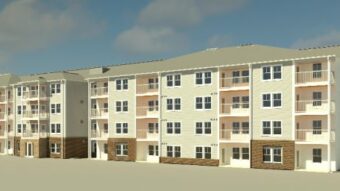The pandemic has caused a lot of consternation among those who work with office real estate. There are worries that tenants will scale back their leases, but not so much in one asset type: single-story office buildings. In fact, this product class is getting fresh looks even during these uncertain times.
“Right now, we have three different suburban single-story assets under contract that total about a quarter of a million square feet. We see an increase in demand for this product type over some multi-story buildings that we’ve had in the market,” said John Homsher, senior vice president, Colliers International | Chicago. “What’s unique is there’s a new attraction as more investors are looking for this product right now than there were this time last year.”
These typically suburban assets provide flexibility and control that are simply not possible in a downtown high-rise. Tenants in single-story buildings can control their own office hours, including coming in during the middle of the night if need be. They manage their own temperature controls, security and cleaning protocols. They can also park right at their own front door and walk directly into their own space, bypassing sometimes congested common areas.
These features—along with their relative affordability, compared to more high-profile properties—has long attracted a certain type of tenant. Those that need to have a back-office function where employees need to be in the space, for example, or training centers and services companies that receive a modicum of customers during the day. For many of these users, their experience with the pandemic has differed from those occupying denser properties.
“The people that I talk to on Zoom calls that are already in single-story are all calling me from their offices,” said Alissa Adler, senior vice president, Colliers International | Chicago. “They’re all saying, ‘We’re back in the office and we’re coming in every day or most days.’ They’re just operating differently.”
Those characteristics that drew a certain tenant type of tenant pre-pandemic are likely to catch the eye of more diverse users now and in the months ahead. The ability to control one’s own cleaning regimen and not to have to share common areas with other users has become deeply attractive amenities during the pandemic.
“We’re very optimistic about the future of single-story occupancy and investment,” Homsher said. “Single-story used to be this asset class off to the side; there was a certain type of tenant that went there, but not every tenant would look at it. In today’s environment, you’ll see a lot more tenants looking at single-story office, which is going to bode well for the sector.”
Landlords of these properties have always had lower overheads than in multi-tenant buildings and they typically don’t have to reconfigure the spaces in between users beyond new paint and/or carpet. Because of this—along with good supply and demand ratios—owners of these properties have been able to maintain or steadily increase rental rates.
A deeper pool of tenants looking for more flexibility and control in the midst of COVID-19 should only further this trend. With no new buildings under construction, high financeability and lower collection risk due to tenant diversity, the single-story asset class is a good hedge for investors looking to avoid the exposure of multi-story product types.
“Stabilized properties are more popular right now in terms of holding their pricing,” said Adler. “The pricing we’ve achieved for the three deals we have under contract are all what we would expect as pricing pre-COVID. We’ve not seen discounts, which I know is a big fear for everybody.”
One of the properties that Adler and Homsher have under contract is Naperville Office Court. The four-building, 66,596-square-foot office complex was constructed in the 1980s and features a number of the assets that many tenants may be looking for during this new reality.
Located at 1801 – 1813 N. Mill Street in Naperville, Illinois, the property includes tenant-controlled HVAC, 24/7 access, on-site property management and 4.5 parking spots per 1,000 square feet of space. Tenants have direct access to their offices as well as to landscaped courtyards.
Office high-rises in the CBD have been waging an amenities war for years to attract new tenants. While most single-story assets don’t have gyms, lounge spaces, cafeterias or other features common to new, Class A towers, they can make the best of what they have to draw in a wider demographic.
Most of these properties have some sort of outdoor component. Some, like Naperville Office Court, have put in a modest community area like picnic benches or other seating. Adler suggests that some owners may look to enhance or reconfigure these spaces to provide more fresh air and an outdoor respite—something missing from virtually every downtown high-rise.
There does exist one risk for investors; once the market better contains COVID-19 in a few years, some new tenants may look to return to multi-tenant buildings with better amenities and more service offerings. This could be offset, however, by firms headquartered downtown creating more satellite offices in the suburbs.
Single-story properties generally attract long-term-hold investors seeking stable cash flow. Though there is unlikely to be a big value-add component for investors looking for a steal, those that know what they are getting into should give these assets another look.




